guide
Internet of Things (IoT) Buyer’s Guide
What is in this IoT Buyer’s Guide?
You’re a machine maker, looking to connect and monitor industrial equipment on site as well as out in the field. Perhaps you also plan to go a step further by creating value-added digital services that significantly differentiate your products and create new revenue streams?
This buyer’s guide to IoT was created to help you find the best IoT platform to deliver the outcomes you want. The marketplace itself is very active! There are a lot of competitors, so it’s important to have a framework to compare them all by.
This guide is divided into six sections:
- What buyers looking for an IoT platform typically want.
- The competitor landscape: The four categories that vendors typically fall into.
- Use cases and the six core capabilities that all IoT projects have in common.
- The four critical phases of an IoT project that help with competitor benchmarking.
- Answering the question: Build or buy? And calculating total cost of ownership.
- Conclusion, including a look at how organizational factors play a role in your IoT project success.
When you’re looking to make such a sizable investment, it’s important to understand the market and ask the right questions. Read the following IoT buyer’s guide to learn more and set your business up for success.
Section 1: What do users want from an IoT platform?
With so many competing providers on the market, finding the right solution for your particular situation can be daunting. Based on our experience and discussions with business leaders about their experiences with IoT projects, we have found that there are seven things IoT users want from their platform:
1. Low technical barriers to entry
Users want a platform that is both technically sophisticated and easy to deploy. This combination gives them the flexibility to test new ideas and establish proofs of concept (PoCs). It also means they can offer lightweight IoT services to their own customers, without the need for their own software engineering team.
2. Ability to rebrand
An important decision criterion is the ability to put your own corporate branding on all customer-facing interfaces. This is essential to make the most of your own brand equity.
3. Costs that scale with usage
Transparent, usage-aligned pricing is a must-have to allow an IoT offering to grow organically the same way a business does.
4. Ease of adding new devices and protocols
Powerful computing without the necessity for coding is not just useful at the beginning of the IoT journey. Who knows what the future will bring, and a platform that can be easily adapted to include new devices or new protocols is a must.
5. Scalability & multitenancy
The ideal solution hosts different users, from external agencies working on different solutions within a larger project to hundreds or thousands of end users, all within one overall system.
6. Portability and flexibility
Users need a system that supports a range of devices in a multitude of diverse and distributed environments. Another key factor is the availability of a range of deployment options, from container-based architecture to different cloud solutions, in out-of-premises data centers and a host of different edge devices.
7. Analytics and dashboards
The ideal system focuses not only on the interface between machine and data, but also on the human side. Here the range of requirements is huge and changing all the time, so flexibility is the only way forward. The ability to add different analytics without dedicated software engineers, and full flexibility on designing a UI to suit each individual user persona made up the final major differentiator.
Section 2: What does the competitor landscape look like?
If IoT is the bridge between devices and data, it should come as no surprise that the different solutions we see today entered the IoT marketplace from one of these two sides. In terms of the technology and engineering aspects of IoT, there is still today a clear separation between the hardware and software platforms, with the majority of vendors focused on the hardware. Interestingly, according to research from IoT Analytics, the number of fully-fledged IoT software platforms has started to drop, falling by 188 companies over the past two years. And of the remaining 613 platform providers (globally), the top 10 have 65% of the market.
The reality of the marketplace makes the following categorization useful for assessing the strengths and weaknesses of different players in the market:
Some providers offer device-focused platforms, with expertise in device management, including provisioning, monitoring, and maintenance. In an overall competitor analysis, these solutions tend to lose points on the data analysis and integration side. These providers typically have a hardware background and might look like a good fit for your needs if you’re interested in a quite narrow, single location implementation such as a smart factory with only a few types of equipment. However, they can’t offer the depth of analytics and data power that other solutions can.
Other providers come from a background in software and offer data-focused platforms. These solutions have proven functionality in data ingestion, processing, and aggregation, and typically come from a trusted consumer software giant. They are able to unlock the full power of the data your devices collect—but if their weakness is in managing devices, how much potentially valuable data is being left on the table?
Very few providers offer balanced platforms, leveraging their experience and expertise in both devices and data. These tend to be the larger, more established IoT providers, and they offer new users the opportunity to benefit from their hard-earned know-how, and partnership ecosystems. But do your own research—you might be surprised at the big players who have yet to develop a balanced solution!
There are also challenger platforms who present themselves as the innovators in the field, selling themselves on simplicity and out-of-the-box functionality. They often offer attractive pricing models and even freeware capabilities, but in the end, they can’t compete with the expertise of providers with tens of thousands of successful implementations in a full spectrum of industries.
What this means for your decision process is clear: If you have existing smart devices and are looking at a primarily data-focused project, it makes sense to speak to a data-focused provider. The same argument can be made that for data-light, narrowly defined smart machinery applications, a device-focused provider might be the right one for you. But in both cases, a balanced provider can offer more than comparable functionality, and you’ll likely future proof your IoT ambitions. Of course, a challenger platform might offer an unbeatable price. How do you make a principled comparison between such different solutions, each one making bold promises? We recommend a structured approach, which we will introduce in section 4. But before that, let’s take a quick look at the most common use cases and the six vital capabilities of an IoT platform.
Section 3: IoT use cases and the six core IoT platform capabilities
As a machine maker, you can use IoT technology to increase the differentiation of your products and create new revenue streams from service contracts. The power of data allows you to decrease costs for maintenance services, avoid unexpected downtime, and improve customer satisfaction at the same time. Higher machine uptime means improved asset utilization as well as optimized energy consumption. There are numerous use cases, but maybe you’re thinking in terms of:
- Remote monitoring
- Smart maintenance
- Performance optimization
- Product life cycle management (PLM)
- Field service management (FSM)
- Equipment-as-a-Service
Whatever the use case, there are six core capabilities that you’ll require of your IoT platform across all IoT projects:
1. Connectivity and device management at scale: This function includes software that enables manual and automated tasks to create, provision, configure, troubleshoot, and manage fleets of IoT devices and gateways remotely, in bulk or individually, and securely. This one might sound obvious, but finding a solution that offers reliable, intuitive device management at scale is harder than it looks. And every difficulty is magnified at scale—an unusual process or counterintuitive workflow might cost ten minutes of headache when running 20 devices but becomes a nightmare when you’re running a thousand.
2. Integration with any architecture or system: The best data in the world with the most interesting actionable insights is of no use at all if it’s stuck inside an IoT platform. It needs to be connected with the other computer systems your company runs to make sure the data and the lessons learned from it get to where they need to be. This function includes software, tools, and technologies, such as communications protocols, APIs, and application adapters, which minimally address the data, process, enterprise application, and IoT ecosystem integration requirements, across cloud and on-premises implementations for end-to-end IoT solutions.
3. Data management: This function includes capabilities that support ingesting IoT endpoint and IoT edge device data, storing data from edge to enterprise platforms, providing data accessibility (by devices, IT and OT systems, and external parties, when required), tracking lineage and flow of data, and enforcing data and analytics governance policies, to ensure the quality, security, privacy, and currency of data.
4. Application enablement and management: This function includes software that enables business applications in any deployment model to analyze data and accomplish IoT-related business functions. Core software components manage the OS as well as standard input and output or file systems, to enable other software components on the platform. The application platform—for example, application platform as a service (aPaaS) — includes application-enabling infrastructure components, application development, runtime management, and digital twins. The platform allows users to achieve “cloud scale” scalability and reliability, and to deploy and deliver IoT solutions quickly and seamlessly.
5. IoT Analytics: This capability includes processing data streams in real-time, such as device, enterprise, and contextual data, to provide insights into asset state by monitoring use, providing indicators, tracking patterns, and optimizing asset use. A variety of techniques can be applied, such as rule engines, event stream processing, data visualization, and machine learning.
6. Deployment from the edge to the cloud: IoT solutions are deployed in a variety of environments with limited connectivity, or with restricted connectivity due to cybersecurity threats. A solution that can operate the same on the edge as in the cloud is a must.
Section 4: The four phases of your IoT project that help competitor benchmarking
If you want to cut through the marketing and compare two or more solutions to see what they really do, it’s vital to have a structured system to carry out your own research. Third-party reports are all based on different comparison methodologies, and thus can disagree on the details of which solution is the very best in each field. They’re a great place to start but not to finish, because each IoT project is unique, and what’s right for others might not be the best for your business.
In order to assess an IoT solution, you have to look in detail at the challenges to be overcome at each phase of the IoT project, and every project has four phases.
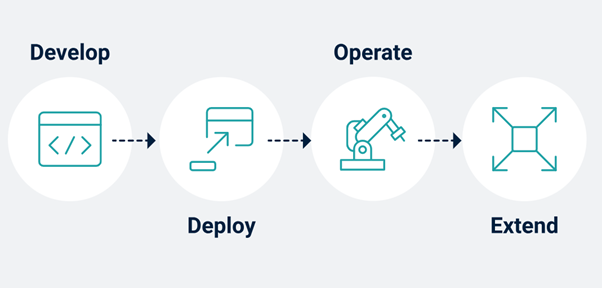
Figure 1: 4 phases of IoT projects.
A project begins with development, and a good solution is built with developers in mind, focused on the developer persona, to enable quick, easy delivery of powerful functionality.
The second phase to consider is deployment, when the theory of use case and platform meets the reality of your devices, your locations, and your system architecture.
Operation is where things really get difficult, as you transition from a project to a product. Ultimately, you need a platform that offers exceptional operational performance. Research shows, however, that many providers struggle to offer anything here that’s more than average.
The final phase to consider is extension—after your platform is performing its designed use cases and delivering business value, you’ll ask yourself, “What’s next?” both in terms of growth in volume and in identifying new implementations and additional sources of revenue. This is where you need to know about the provider’s platform ecosystem of hardware and software partners to help you get the most out of your IoT system.
In the next section, we’ll drill down to look at the key differentiators in each of these four phases.
How do I choose the IoT solution that’s right for me?
When it comes to selecting the right provider, here are the key differentiators you need to consider at each of the four phases of an IoT project.
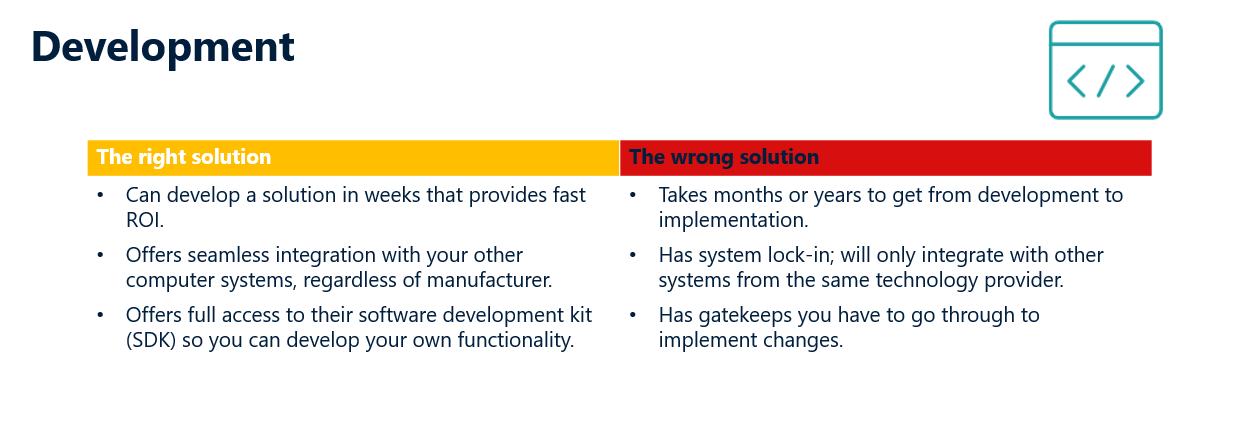
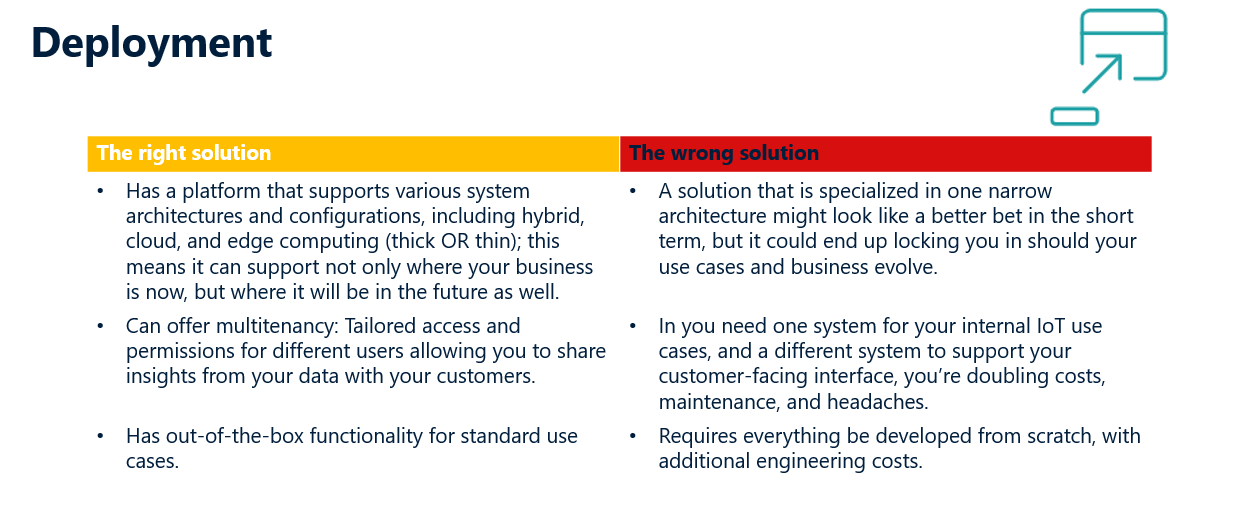
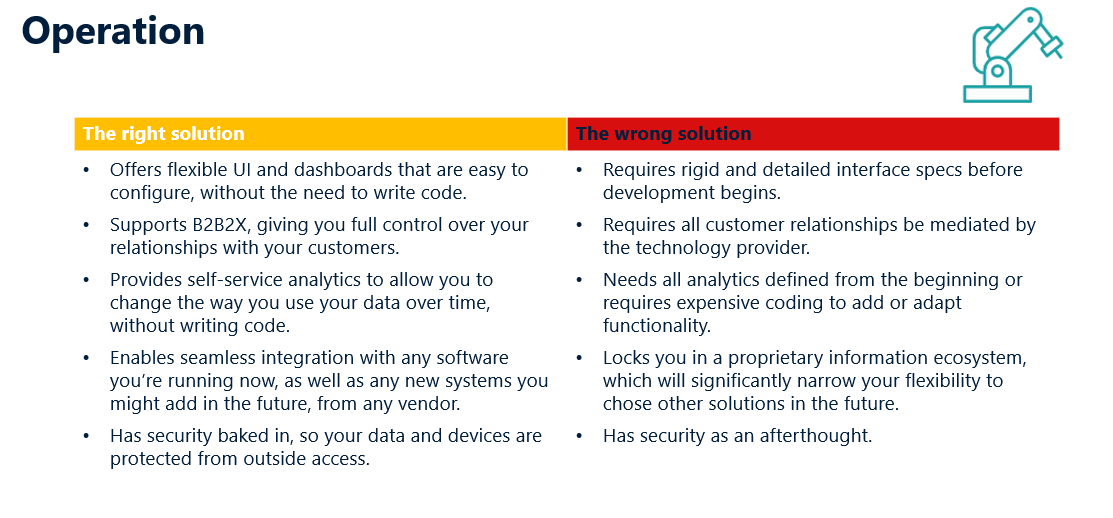
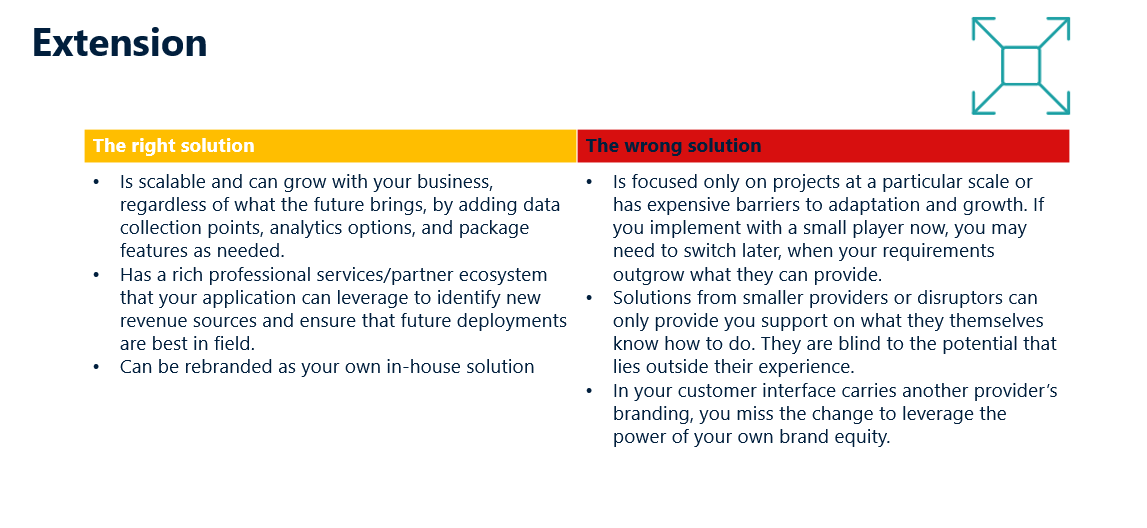
Section 5: Should I consider building our own platform?
In an ideal world, when you want something to be exactly the way you like it, you go out and build it yourself. The same question is often asked at the beginning of Internet of Things projects. Do you have a go yourself? Is your IT staff experienced, and do they have the proper domain expertise? Will you be able to integrate your systems and scale properly? Will you be able to meet security requirements and adapt to future IoT sensors and networking complexity?
Many early pioneers of IoT built their own IoT platforms and then had “builder’s remorse” when they were unable to scale the IoT solution or required outsized investments of time and resources to stand up and maintain. After all, if my current IoT use cases are narrow and well-defined, does it make sense to pay an external IoT platform provider, or would I be better off building a simpler application enablement platform in-house?
The way this question is usually phrased gives the impression that there are really only two options: build or buy. However, there is a third option, a hybrid model that is gaining share in the IoT market—this is what some providers are calling “buy & build.” The idea is to start with a proven IoT platform, which can deliver initial operations, and thus value and return on investment, in weeks rather than months. The user can then invest software engineering time and money to build out custom functionality on this stable foundation. Building your own solution from scratch can take months to deliver a working piece of software, even if you’re working with a partner who can provide you with the building blocks of code And as anyone in the industry can tell you: It’s not the coding that’s painful. It’s the testing. This is the hidden risk inside every software development project—and it’s a risk you can bypass by going with a provider who can supply an IoT platform that’s ready to use: tested, secure, and reliable. You can then build the functionality you need on this stable, proven foundation.
Another important decision factor, of course, is cost, and the best way to get a handle on this is to calculate the Total Cost of Ownership of your chosen solution. By inputting the number of IoT devices you predict you will use over a 5-year period, and adding up all the associated costs of each device, your deployment model, and the cost of labor, as well as your preferred model: device/data/both—you can start to get an impression of what the total cost of building an enterprise-grade platform is, compared to buying one in as a service.
Section 6: Conclusion
So, what are the most important things to bear in mind when choosing the right IoT platform for your business? First, you should probably be choosing a provider that can offer a balanced platform, with expertise in both devices and data. Flexibility is key, to fit to diverse and changing system architecture and be able to pivot to new use cases and revenue streams as they arise. You’re looking for a provider that is strong on application and business systems integration. You need a solution that can face the challenges of all four project phases. And a provider that has a strong vision of where their solution fits into the marketplace, coupled with a rich partner ecosystem. This last point cannot be emphasized enough: IoT is a team sport. The big players in the field don’t only offer their customers a partnership with them—they open the doors to a rich ecosystem of professional services and partners, which can be of benefit now and in the future. This includes hardware manufacturers, connectivity experts, security consultants, data scientists, domain experts, systems integrators, and application designers.
But choosing the right IoT platform is only half the battle. Organizational alignment also plays a central role in the success of IoT projects. Research has identified four major differences between IoT projects that win and those that fail, so here is what needs to be done in your business to make sure your IoT project succeeds:
1. Set clear goals – Be clear from the beginning what functionality you need, and what use cases you plan on using. Remember, other use cases can and do emerge over time, but if you don’t have a plan for what you want, it’s hard to know if you’re going the right way.
2. Take an organization-wide approach – The data that you will collect and the insights it will generate are just not an IT issue—they can impact every part of your organization. It’s vital to elicit contributions and ensure buy-in across the organization before implementing an IoT project.
3. Understand the tech challenges – Working with an experienced partner allows you to benefit from their experience, and ideally learn from the mistakes of others without having to make them yourself! The right solution depends on what your devices are, where they are, how accessible they are, and a whole host of other questions. It’s vital to understand the project and its technical scope before you get started.
4. Leverage the power of ecosystems – While the primary function of your IoT project might be to enable a single use case, be alert for secondary uses this data can be put to. Your customers can benefit from the predictive maintenance data you collect from the machines they use, just to give one common example. However, if your provider doesn’t enable the flexibility to adapt to evolving use cases in an increasingly digital world, you’re going to miss out on the potential of IoT to unlock business value in areas you never even dreamed of.
We think the information in this IoT buyer’s guide will help you to make the choice that’s right for your business and your customers. Naturally, we believe there’s a good chance that Cumulocity might be the platform you’re looking for. If you’d like to find out more about what we can do for your business, feel free to get in touch.